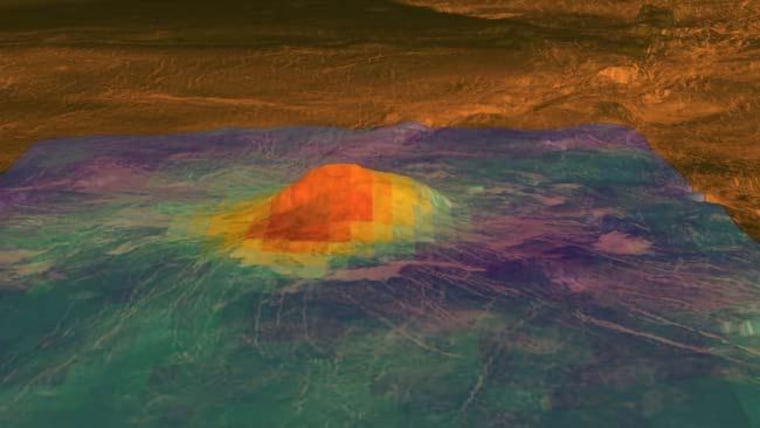New evidence for recently active volcano hotspots on Venus like those that created the Hawaiian Islands has been found in new observations by a European spacecraft.
These relatively young and potentially active surface features could give scientists clues to how the planet has resurfaced over the last billion years, which in turn could help better understand the interior dynamics of Venus, as well as climate change on Earth's nearest neighbor and on Earth itself.
The hotspots on Venus' hellish surface were first recognized by NASA's Magellan spacecraft, which entered orbit around the planet in 1990. These hotspots stood out because they had a distinctive rise in topography, volcanic centers and telltale gravity signatures.
The hotspot sites were the most likely candidates for recent volcanic activity on the surface of Venus. The question of whether or not Venus' surface is geologically active has been a major one in studies of the planet, but it wasn't clear just how young the features were.
"We were getting warm there, but not actually hot," said Suzanne Smrekar of NASA's Jet Propulsion Laboratory, a member of the team that analyzed the new observations taken by the European Space Agency's Venus Express probe.
Young lava flows
An instrument aboard Venus Express, ESA's first probe to Venus, mapped thermal emissions from the southern hemisphere of Venus, which indicate differences in the composition of the surface. Unusually high emission patterns were seen around the only three of the nine known hotspots that Venus Express could image: the Imdr, Themis and Dione Regiones.
Surface regions that are old would be expected to have patterns of low emissions because of long exposure to weathering from Venus' harsh atmosphere. So the high levels of emissions from these hotspots, plus the evidence from Magellan, "all point to the fact that these are recent [volcanic lava] flows," Smrekar told Space.com.
Exactly how young the features are is hard to pin down because of limited information about the environment at Venus' surface and the composition of its lower atmosphere. Smrekar and her colleagues estimate that the lava flows are younger than 2.5 million years, possibly even as young as a few hundred to tens of thousands of years old.
To pin down the age of the flows would likely require sending a lander to the Venusian surface. The most recent landers to visit were the Soviet Venera probes in the early 1980s. Future landers could get better measurements of conditions there, which would aid lab experiments that try to mimic weathering processes on the sweltering planet's surface.
Resurfacing question
The young age of the hotspots has implications for understanding how Venus might have been resurfaced.
Magellan data showed that the surface of Venus had few craters. It is known that the solar system has undergone periods of heavy bombardment in the past, leaving evidence that is still visible on ancient unchanged surface, such as that of Earth's moon. Thus, the evidence suggested that Venus has been resurfaced since then.
One suggestion to explain the resurfacing is a catastrophic event that would have buried the planet's surface under about 1 mile (1.6 kilometer) of lava. Such an event might have been caused by unknown, exotic interior processes unlike those that operate within the Earth. If this was the scenario that played out, "Venus would have had to be essentially dead since then," Smrekar said.
The other idea for Venus' resurfacing is a more gradual, small-scale process that would imply that volcanism was still happening today and that Venus had an interior more like Earth's, though Venus would still lack Earth's surface-reshaping plate tectonics.
The estimated young age of the hotspots suggests that the latter is the case on Venus and that the planet "doesn't have to have had this exotic resurfacing event," Smrekar said.
Climate change and bright spots
A volcanic eruption was put forward as a possible explanation to a strange bright spot seen in the atmosphere of Venus last year. Smrekar and several of her colleagues are following up on this event to see if a volcanic eruption from one of these hotspots coincides with the spot and could feasibly explain it. If so, then that link could serve as further evidence that Venus' volcanoes are still active.
"We're kind of going from warm, warmer, warmest to maybe really hot," Smrekar said.
Determining whether or not Venus is still active and what kind of processes govern its interior could also help scientists better understand what kinds of planets might potentially be orbiting other stars.
"It's a great laboratory for understanding terrestrial planets," Smrekar said. "What's really the anomaly [among these planets] — is it Venus, or is it the Earth?"
Understanding the processes at work on Venus — in particular, volcanic eruptions — can also help scientists better understand climate change, both on Venus and on Earth, Smrekar said, because volcanoes spew gases into the atmosphere that can change the composition of the atmosphere and the amount of sunlight that hits a planet's surface.
The new observations are detailed in research published online Thursday by the journal Science.
